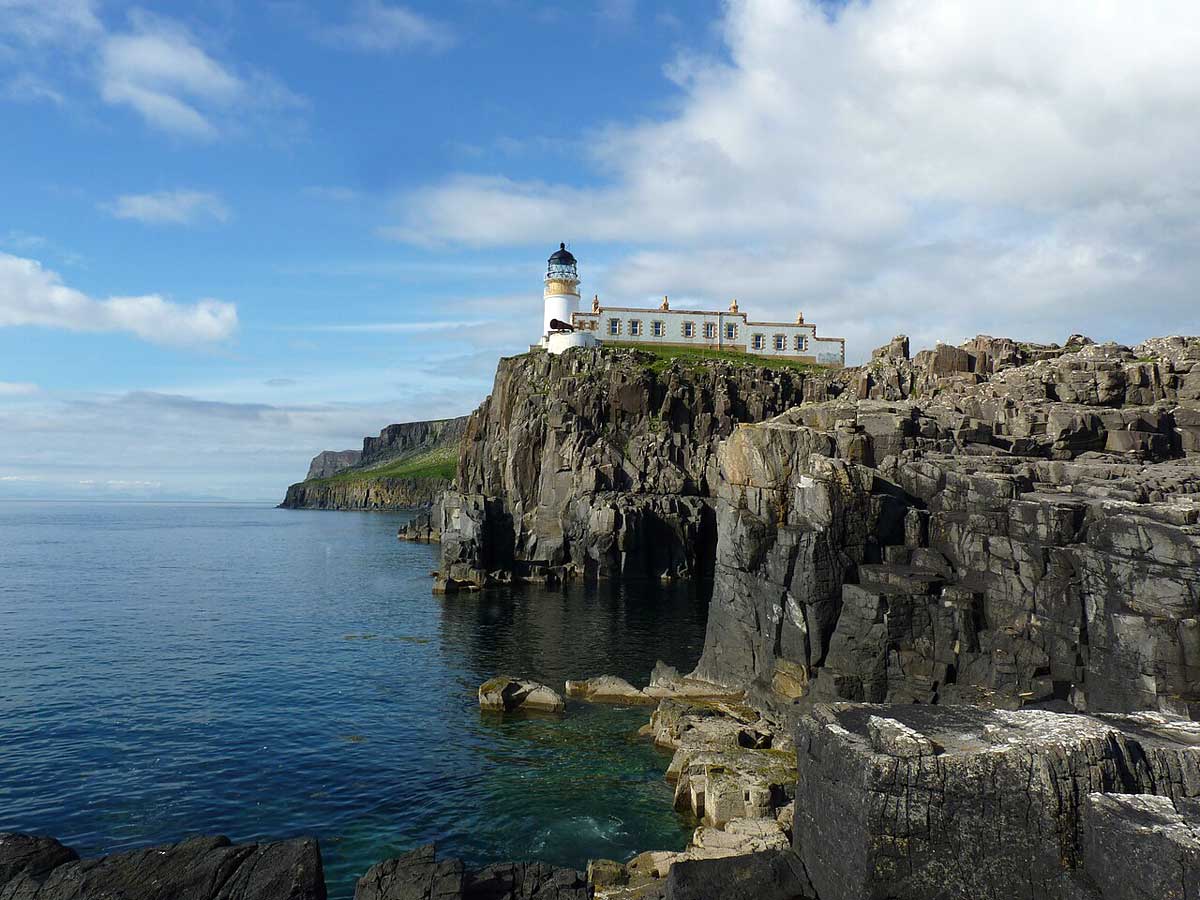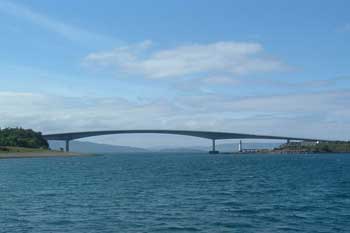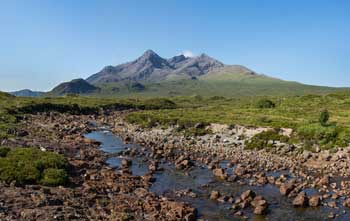
The Isle of Skye, located on the west coast of Scotland, is a beautiful and popular destination for visitors.
The Isle of Skye, its name taken from the Old Norse meaning “cloud island,” offers a wide range of outdoor activities, wonderful landscapes, and cultural experiences
Although it is only 50 miles long by 25 miles wide it’s the largest of the Inner Hebridean islands sitting on the same northerly latitude as Moscow and Hudson Bay Thankfully it benefits from the warm Gulf Stream currents.
Its rugged beauty with brooding mountains, sparkling sea lochs and tumbling rivers draws thousands of visitors to its shores making it one of Scotland’s top three tourist destinations after Edinburgh and Loch Ness.
Skye Bridge
Most of the visitors who arrive on the island will use the toll-free Skye Bridge to cross from Kyle of Lochalsh on the mainland. The bridge is much quicker and more convenient than the old ferry which stopped in 1995.

A much less well-known way of arriving on Skye is the short ferry crossing, which only runs in the summer month, between Glenelg on the mainland to Kylerhea, near Kyleakin on Skye.
It’s a unique service, now community owned, which runs the last manually operated turntable ferry in Scotland.
If you are heading for the southern part of Skye, you can take the ferry between Mallaig on the mainland to the small ferry port of Armadale on the far south western Sleat Peninsula.
Windswept Uig, a small village on the western side of the Trotternish peninsula is the location of the ferry terminal to the Western Isles. From here Caledonian MacBrayne will take you to Lochmaddy in North Uist and Tarbet on the Isle of Harris.
To the north of Uig, in the small settlement of Kilmuir, lies the Flora MacDonald memorial, a testament to her bravery and the help she gave to Charles Edward Stuart (Bonnie Prince Charlie).
What to see on the Isle of Skye
Portree
Many visitors head first to Portree, the main town on Skye, (around 35 miles on the A87 road from the Skye Bridge). The road (the original was built by Thomas Telford) runs through the small village of Broadford which stands on the edge of the Red Cuillin Mountains.
Portree, which looks out to the east on the smaller Island of Raasay, is a busy tourist centre set around a picturesque natural harbour lined by a number of colourful houses.
It has the bulk of the island’s hotels, shops and restaurants. It is also the island’s main cultural hub with theatre, concerts and cinema. It’s often used as a base for touring the rest of the island.
Armadale Castle, Gardens & Museum
Armadale Castle is located in Armadale, Skye. It was once the seat of the MacDonalds of Sleat, part of the Clan Donald.
Although the castle is now in ruins it is still a popular visitor attraction, thanks to its dramatic setting overlooking the Sound of Sleat and its beautiful gardens.
The Clan Donald Centre is housed in the former stable block.
The Clan Donald Lands Trust which manages the site says “We are working on plans to stabilise the structure to enable full access.”
- Visit the official Armadale Castle website for more information.
Continuing south from Armadale, a short drive (four miles) takes you to the small community of Aird of Sleat a great place to leave the car and walk to Skye’s most southerly point, aptly named the Point of Sleat.
It’s a beautiful, round trip walk of around 10 miles. A walker is well rewarded with fantastic views along the way. On a good day, the smaller islands of Eigg and Muck are clearly visible and if you like to dig your toes in the sand, the beach at Camas Daraich is worth a visit.
Without a doubt, Skye’s most spectacular natural features are the Red Cuillin and the much more serious Black Cuillin mountains separated by Glen Sligachan.
They are the most dramatic and spectacular mountains in Britain.

The area draws serious climbers, particularly in the winter, from around the world but there are also plenty of less strenuous walks to be tackled.
The area’s magnificent scenery also attracts artists and photographers. For many, it is the best view on Skye
Climbers can approach the area from the Sligachan Hotel, which offers, camping, self-catering holiday cottages and the hotel facilities which include one of the biggest ranges of malt whisky in the country.
The hotel is about 23 miles from the Skye Bridge and nine from Portree.
Alternatively, the Cuillins can be approached from Glen Brittle, on the opposite side of the island.
Talisker whisky distillery on the Isle of Skye
The Talisker Distillery, owned by Diageo lies on the shores of Loch Harport in the village of Carbost. It’s an eight mile journey from the Sligachan Hotel. The distillery does operate a number of tours and tastings.
Visit the official Talisker Distillery website for more information.
For whisky lovers, the distillery on the nearby Island of Rasaay is well worth visiting too. Only a short ferry journey from Skye the historic Isle of Rasaay Distillery offers tours and tastings (for gin lovers too.)
Edinburgh whisky distilleries.
Dunvegan Castle
Dunvegan Castle, for eight centuries the ancestral home of the Chiefs of the Clan MacLeod lies, on the edge of Loch Dunvegan, a little north of the village.
The castle, which is open to the public, sits within five acres of formal gardens; it’s one of these ‘must see’ visitor attractions on Skye.
You can take a boat trip on the loch, enjoy the variety the gardens have to offer or stay in one of a number of holiday cottages within the castle grounds.
The nearby village of Dunvegan has a range of small shops, hotels and bed and breakfasts and a tourist information office.
The world-famous Three Chimneys restaurant with rooms lies around five miles from Dunvegan
More Isle of Skye attractions
- Fairy Pools: These crystal-clear pools and waterfalls, located in Glen Brittle, are a popular hiking destination. The water is frigid, even in summer, but the scenery is magical.
- The Old Man of Storr: This iconic rock formation is one of the most famous landmarks on Skye. It’s a moderately challenging hike with rewarding views.
- Quiraing: With its unusual landscape of pinnacles, and landslips on the Trotternish Peninsula, it’s a great place for hiking.
- Neist Point Lighthouse: Located on the westernmost point of Skye, the lighthouse provides fantastic views of the cliffs and the ocean.
- Kilt Rock and Mealt Falls: A viewpoint where you can see the striking Kilt Rock cliffs and the Mealt Waterfall cascading into the sea.
- Coral Beach: Located in the north of Skye, this beach is famous for its white coral-like sands and turquoise waters.
Isle of Skye travel
Getting around the island by car is a much easier option but beware of the many single-track roads. There is a driver’s etiquette for negotiating these narrow one-lane roads.
If you haven’t driven on this type of road before, you do need to have your wits about you, particularly during the summer months when visitor traffic is heavy.
Travelling around the island by public bus is more problematic. While they will run between some of the larger centres, much of remote Skye is difficult to reach by public transport. The Post Bus may fill in some of the gaps; it’s an option worth checking out.
Travelling from Edinburgh to the Isle of Skye
You can get to Skye from Edinburgh in a number of ways including a combination of trains and buses. The best way is to drive or take an organised tour.
Of course, there are a few different driving routes you could take. You could, for example, go via Stirling, head through the Trossachs to Glencoe and on to Fort William, then Invergarry, Kyle of Lochalsh and the Skye road bridge.
This journey, which could take you over five hours, will take you through some of Scotland’s most magnificent scenery.
The nearest international airports are Glasgow and Edinburgh and Inverness is the closest local one.
Further information about the Isle of Skye.
For more information visit the official Isle of Skye visitor website.